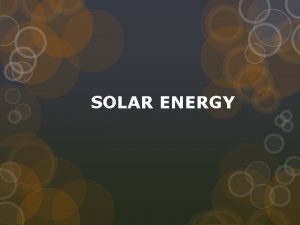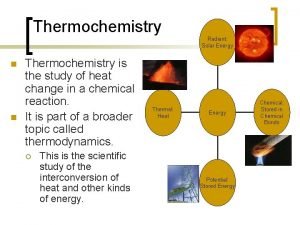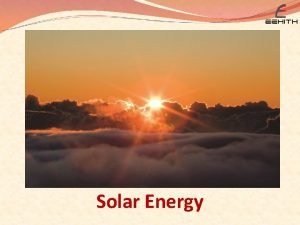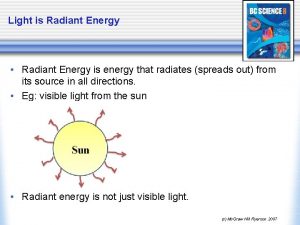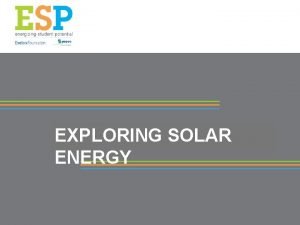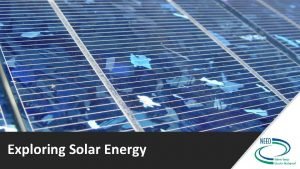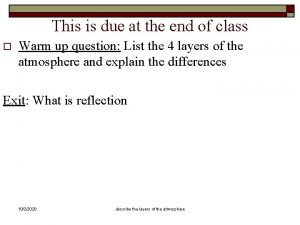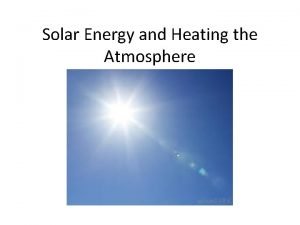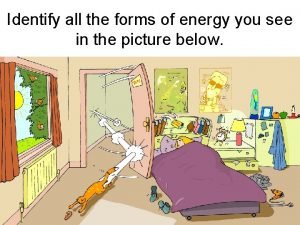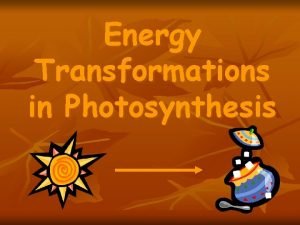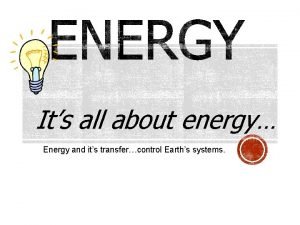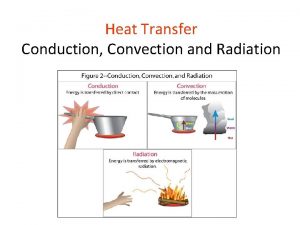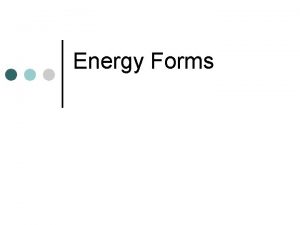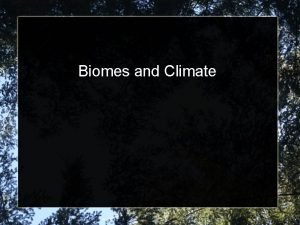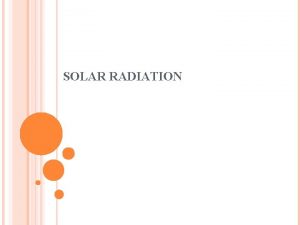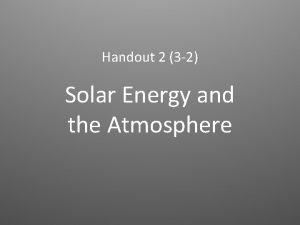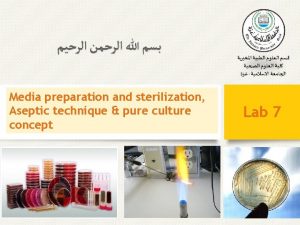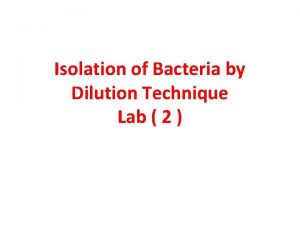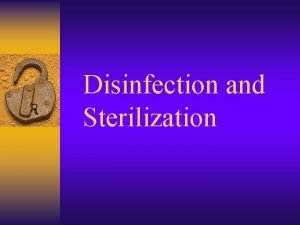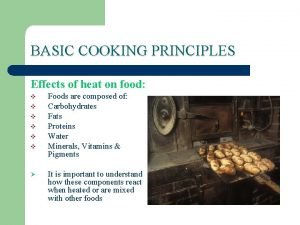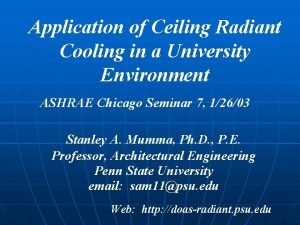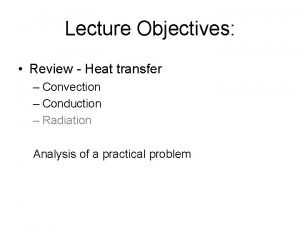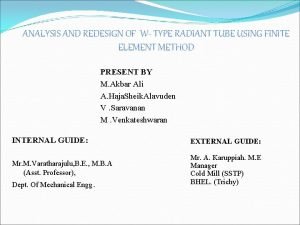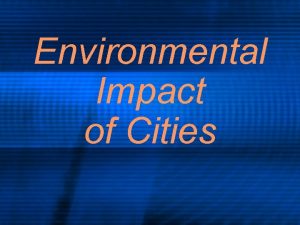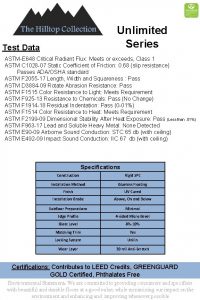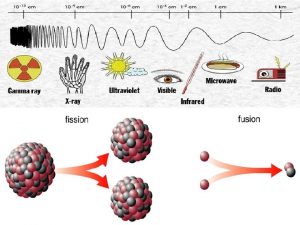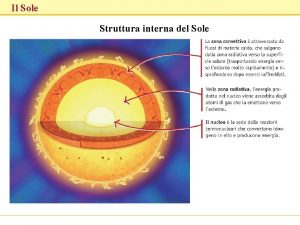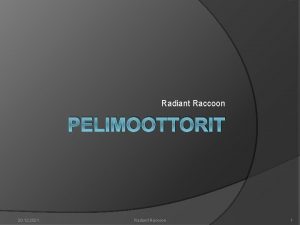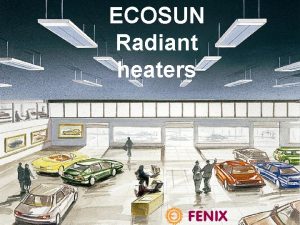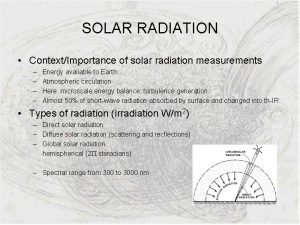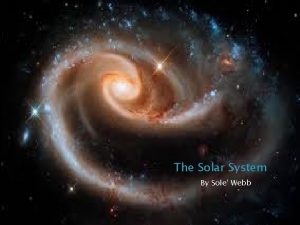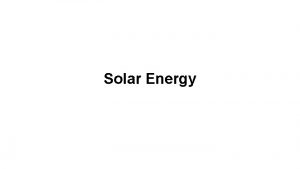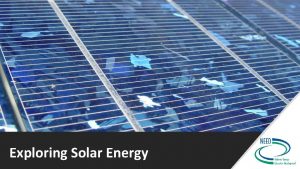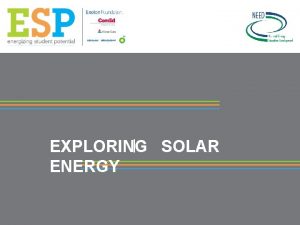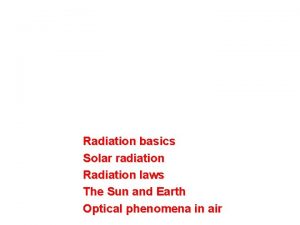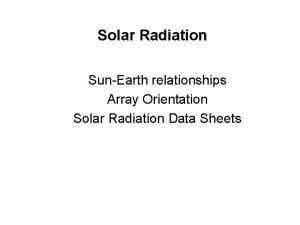SOLAR RADIATION Radiant energy is the sole energy






































- Slides: 38

SOLAR RADIATION

Radiant energy is the sole energy source that can be used by green plants. When a leaf intercepts radiant Radiant energy and photosynthesis energy it may be absorbed, reflected or transmitted. Part of the fraction absorbed reaches the chloroplast, fuelling photosynthesis, the process where radiant energy is used to convert water and CO 2 into sugars. 辐射能和光合 作用 绿色植物能够利用的惟一能源是辐射能。当叶子截 获辐射能时,它能被吸收、反射或者透射。吸收的 部分能量到达叶绿体,引发了光合作用,在这个过 程中,辐射能被用于转化水和二氧化碳成为糖。

Solar radiation contains a spectrum of different wavelengths. However, only a restricted band of this spectrum is effective for photosynthesis. This is the band of photosynthetically active radiation (PAR) and for green plants lies between 380 and 710 nm. 太阳辐射包含了不同波长的光谱。然而,仅有一个有限的光 谱带对光合作用是有效的。这就是光合活性辐射(PAR)带, 对绿化植物是位于380 nm到 710 nm之间。


The rate of photosynthesis is a gross measurement of the rate at which a plant captures radiant energy and fixes it into Measurement of photosynthesis carbon compounds. Net assimilation is the difference between photosynthetic assimilation and losses due to respiration. Therefore, not assimilation will be negative in the dark and will increase with increasing PAR. The intensity of PAR at which the gain in photosynthesis equals the losses is known as the compensation point. 光合作用速率是总速率的测量,即植物捕获的辐射能,并 把它固定到碳的化合物中。光合作用净同化是同化量的呼 光合作用的 测量 吸的丢失量之差。因此,净同化在黑暗中是负值,并随PRA 增加而增长。在光合作用的同化量等于呼吸消耗量时的PRA 强度,称为补偿点(compensation point)


Plants rarely achieve their full photosynthetic Changes in the intensity of radiation potential, due to water shortage and to variation in the intensity of radiation. The systematic variations in light intensity are spatial and temporal of solar radiation. Less systematic variations in light intensity are caused by the positioning of leaves in relation to each other. 植物很难获得它们完全的光合作用潜能,是由于水 辐射强度的 变化 短缺和辐射强度的改变。光强度的系统变化是太阳 辐射的空间和时间的差异。光强度中极少部分的系 统变化是因叶子彼此的相对位置引起。


A major difference in the photosynthetic capacity of plants is that between C 3 and C 4 plants are C 3 and C 4 plants able to capture CO 2 with greater water use efficiency than C 3 plants, but this advantage comes at an energy cost. In C 4 plants the rate of photosynthesis increases with light intensity, whilst photosynthesis tails off with increasing light intensity in C 3 plants. 植物光合能力中的主要差别是在C 3和C 4植物之间。 C 3和C 4植物能捕获CO 2 ,伴随着水的利用效率比C 3植物 更大,而这优点需要消耗能量。在C 4植物中,光合作 用率随光强度而增加,而C 3植物随光强度增加光合作 用渐渐减小。


A major strategic difference between plant species in their response to the intensity of radiation is exhibited Strategic and tactical response of plants to radiation by ‘sun species’ and ‘shade species’, which possess a range of adaptations to high and low light levels, respectively, Also, plants may grow leaves which develop differently under different light conditions as part of a tactical response to the light environment. This is most clearly seen in the formation of sun leaves and shade leaves within a leaf canopy of single plant. 植物种间对辐射强度反应的主要战略差异显示为“阳地 种”和“阴地种”,它们分别具有适应于高的和低的光辐 植物对辐射的 战略和战术 响应 射范围。同样,植物能够在不同光条件下生长不同的叶 子,作为对光环境的部分战术反应。这一点最清楚地在 单株植物叶冠内的阳叶和阴叶的结构上看到。




春 秋 冬 夏 夏 冬 秋 春 The seasons in the Northern and Southern Hemispheres







TEMPERATURE The rate of an enzyme catalyzed reaction increases with temperature. The temperature coefficient (Q 10) is an index Ecological Effects of temperature of the effect of a 10℃ temperature rise on metabolic rate, and is often near 2. 0. Within the nonlethal temperature range the most important effect on organism of temperature is likely to be its effect on growth and development. 温度的生态作用 酶催化反应的速度随温度而增加(温度系数 (Q 10) 是温度升高 10℃对代谢速度影响的指 数,经常大约为 2. 0)在非致死温度范围内, 温度对生物最大的影响很可能是影响了生长 和发育。




Temperature may also act as a stimulus, determining whether the organisms will begin development. Vernalization is the Vernalization and Acclimation induction of flowering by low temperatures. Exposure of an organism to higher (or lower) temperatuers in the laboratory can alter the organisms temperature response. The habituation of an organism’s response to changes in laboratory environmental conditions is termed acclimation. Acclimatization is the habituation of an organism’s physiological response to changes in natural environmental conditions. 温度能够作为一种刺激物起作用,决定有机体是否将开 始发育。春化法是通过低温诱导开花。有机体在实验室 春化和驯化 里暴露到较高(或较低)的温度能够改变有机体的温度 反应。有机体对实验环境条件变化产生的适应性反应称 为驯化(acclimation)。有机体对自然环境条件变化产 生的生理适应性反应称为气候驯化(acclimatization)。

High temperatures may lead to enzyme inactivation Temperature thresholds or the unbalancing of components of metabolism; for example, in plants, respiration may proceed faster than photosynthesis, leading to death, however, the most frequent effect of high temperature on organism is dehydration. All terrestrial organism must conserve water but at high temperatures rates of water loss can be lethal. 高温可能导致酶失活或代谢组分不平衡,例如植 物的呼吸作用快于光合作用而导致死亡。然而高 温 度 阈 温对生物最普遍的影响是引起脱水。所有陆生生 物必须保持水,但在高温下失水率能够成为致死 因子。

There are large differences between the low temperature tolerances of differing species, associated with the processes of freezing, chilling and hardening. Many are killed by temperatures below – 1℃ due to the damaging effects of icecrystal formation within cells. 不同物种对低温的耐受性有很大的差异,这与结冰、寒冷 和坚硬的过程有关。温度低于-1℃时很多物种被冻死,这 是由于细胞内冰晶形成的损伤效应


The effects of temperature on individuals may be Allen’s rule moderated by evolved differences. Allen’s rule states that endothermic animals from cold climates tend to have shorter extremities (ears and legs) compared with animals from warmer climates, thus reducing their surface area: volume ratio. This rule has widespread applicability. 阿伦法则(Allen’s rule)陈述了来自冷气候中的内 阿伦法则 温动物与来自温暖气候的内温动物相比,趋向于具 有更短的末端(耳朵和四肢);因此降低了它们的 表面积对体积的比率。


Bergmann’s rule states that mammals tend to be larger in colder areas than warm climates, again to reduce their surface area: volume ratio. . 贝格曼规律(Bergmann’s rule)讲述了寒冷地区的哺乳 动物比温暖地区的哺乳动物个体趋向于更大,也减低了 它们的表面积与体积的比率。






 Solar energy is radiant light and heat
Solar energy is radiant light and heat Balanced thermochemical equation
Balanced thermochemical equation How does archimedes principle relate to convection
How does archimedes principle relate to convection Energy times distance
Energy times distance Solar energy is free. solar is inexhaustible
Solar energy is free. solar is inexhaustible Radiant energy
Radiant energy Radiant energy.
Radiant energy. Radiant energy
Radiant energy Solar energy
Solar energy Radiant energy
Radiant energy Radiant energy
Radiant energy Energy transformation of a blender
Energy transformation of a blender Energy transformations in photosynthesis
Energy transformations in photosynthesis Concept map of energy
Concept map of energy Example of convection
Example of convection Example of chemical energy
Example of chemical energy Solar radiation has a part in the water cycle by
Solar radiation has a part in the water cycle by National solar radiation database
National solar radiation database What receives the most solar radiation
What receives the most solar radiation Solar radiation
Solar radiation Solar radiation
Solar radiation Wholesalesolar.com/solar panels
Wholesalesolar.com/solar panels Wind energy is an indirect form of
Wind energy is an indirect form of Resucitaire
Resucitaire Principle of sterilization
Principle of sterilization Streaking method
Streaking method Disinfection and sterilization
Disinfection and sterilization Radiant logic ldap
Radiant logic ldap Means to cook from radiant heat from above.
Means to cook from radiant heat from above. Hybrid radiant doas
Hybrid radiant doas Latent loads in radiant cooling
Latent loads in radiant cooling Objectives of heat transfer
Objectives of heat transfer Radiant panel test
Radiant panel test Radiant floor heat exchanger
Radiant floor heat exchanger Radiant ferroelectric testing
Radiant ferroelectric testing W-type radiant tubes
W-type radiant tubes Radiant city
Radiant city Partial varia breast shapers
Partial varia breast shapers Astm e 648
Astm e 648
